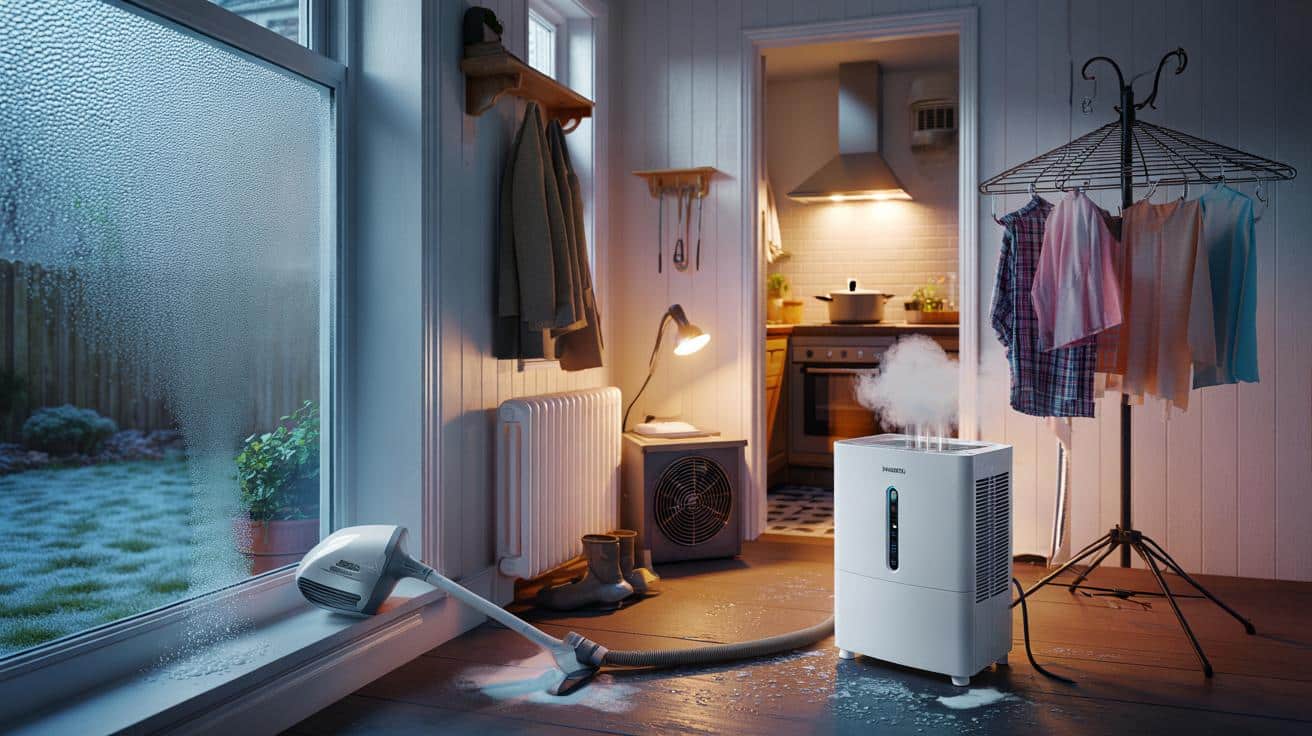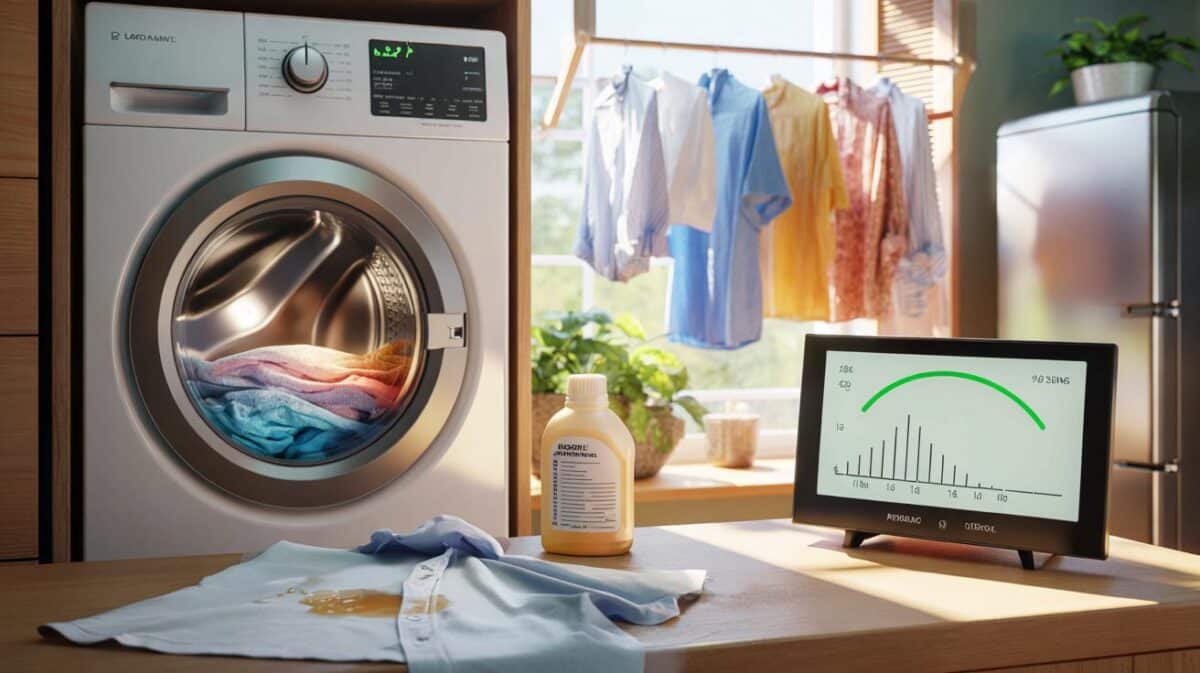Winter traps moisture indoors. It settles into fabrics, clings to walls, and lingers in rooms that never quite warm through. The result is that stubborn damp smell that greets you before you’ve even kicked off your boots.
The hallway smelt like a forgotten swimming pool locker: coats still wet from the bus stop, pram wheels flecked with rain, radiators clicking to life. I ran a hand across the bedroom window and gathered a small tide of condensation on my palm. The dehumidifier hummed politely in the corner, like a fridge that had opinions. I could smell the wool coat before I saw it. The kettle boiled for tea, the tumble dryer creaked into its cycle, and somewhere the bathroom fan fought for a little oxygen in the fog. Something had to change. A tiny change, repeated daily.
Here’s the thing most homes quietly tell you in winter: moisture loves stillness. It floats around as vapour, then kisses a cold surface and turns to liquid. That’s where the musty odour starts—fabric fibres, plaster skim, skirting board corners. You notice it strongest in rooms that don’t get much sun, or where doors stay shut and coats stay piled. Moisture is a gas until it meets a cold surface. Once it lands, bacteria and mould get to work. Not dramatic, just slow and steady. The fix isn’t fancy. It’s about nudging air, capturing water, and using the appliances you already own in a smarter, gentler rhythm.
In a small terraced house in Leeds, a couple I met had a winter ritual: socks on a heated airer in the box room, bathroom door propped open after showers, kitchen window cracked while the pasta boiled. They added a 12-litre dehumidifier on a smart plug by the clothes horse, set to 50% humidity. After a week, their bedroom windows stopped puddling every morning. Their cheap digital hygrometer slipped from 72% RH to 52%. The hallway odour faded, along with the grey halo around a long-suffering skirting. It wasn’t instant. It was quiet. That’s the shape of progress in a British winter.
Think of damp odour as a chemistry problem with a domestic soundtrack. Warm air holds more moisture than cold, so when that warm air brushes a cold pane or a north-facing wall, it dumps the load. That slick film feeds microbes, and microbes make smells. To break the cycle, aim for indoor humidity between 40% and 60%. Use heat to lift moisture into the air, then give that moisture an exit or a trap. Extractor fans are exits. Dehumidifiers are traps. Tumble dryers, if maintained, are bridges—moving water from fabric to a tank or outdoors. Every appliance choice changes the room’s microclimate by a few percentage points. Those points add up.
Start with extraction where steam is born. Run the kitchen hood on medium with lids on pots, and crack a window a finger’s width. Bathrooms want a fan that runs on after you leave—ten to twenty minutes makes a world of difference. UK regs point to 15 l/s for bathrooms and 30–60 l/s for kitchens, which is tech-speak for “more than a token whirr.” Upgrade to a humidity-sensing model if yours is shy, and clean the grille every couple of months. In practice, that means fewer wet tiles, less condensation drifting into bedrooms, and a fresher landing. It’s a small habit that pays rent in dry towels.
Now, the dehumidifier: place it where moisture actually happens, not where it looks tidy. A laundry room. The steamiest corner of an open-plan kitchen. The cold spare room where bedding goes to hibernate. Close the door, set it to 50% RH, and let it run until the tank fills or the number settles. Compressor units are frugal in heated spaces; desiccant types shine in cooler rooms and give off a little warmth. Laundry mode can pull two mugs of water from a single wash on an airer. And at roughly 150–250 watts, you’re paying pennies per hour—often less than a kettle boil stretched over time.
Drying clothes is where good intentions go to smell. Don’t drape wet laundry on every radiator and then wonder why windows cry by breakfast. Use a tumble dryer that’s actually breathing: clear the lint filter every cycle, check the vent hose isn’t crushed, and rinse a condenser’s heat-exchanger monthly. Heat pump dryers cost less to run than older condensers, and they’re kinder to fabrics. Pair a covered heated airer with a dehumidifier in a small room, door shut, and you’ll halve drying time without fogging the house. Let’s be honest: nobody really scrubs fan filters every week, so build routines you’ll stick to. Aim small. Repeat often.
There’s a simple test for whether your air is holding too much water: the morning window wipe. If you’re squeegeeing liquid off the glass, use a window vac and pour the day’s damp down the sink. Move furniture five centimetres off external walls to stop cold spots from becoming smell factories. And don’t forget the washing machine itself—run a hot maintenance wash, clean the door seal gunk, and leave the door and drawer ajar. Think of it as giving moisture fewer places to hide. Small moves, kinder air.
“Smell is your house whispering that moisture has found a cold friend,” a repair tech told me. “Move the air, move the water, and the whisper shuts up.”
- Set extractor fans to overrun for 10–20 minutes after steam-heavy tasks.
- Place a dehumidifier by your drying rack; close the door; set 45–55% RH.
- Clean tumble dryer filters and, for condensers, rinse the heat-exchanger monthly.
- Use a window vac on morning condensation; empty it like a tiny rain barrel.
- Leave washing machine and dishwasher doors ajar after cycles to air seals.
Homes behave better when you keep them gently warm rather than swinging hot–cold. A steady 18–20°C helps air carry moisture to a fan or a dehumidifier instead of parking it on your walls. Circulation matters, too. A small desk fan on low can kick stale corners back into the room’s flow, and many ceiling fans have a winter reverse mode to push warm air down without a draft. Air purifiers won’t dry the air, though carbon filters can soften lingering odours. If you need to choose, prioritise removing moisture over masking smells. We’ve all had that moment when we walk in and the house smells “old,” even when it isn’t. That’s moisture talking, not age.
There’s an honesty to winter housekeeping. It’s not glamorous. It’s wiping the sill, listening for the fan’s run-on, and emptying a tank that looks like sky in a jug. If you cook, crack a window. If you shower, keep the fan running. If you dry clothes, give the water somewhere else to be. None of this takes a tool belt. It’s habits plus appliances, nudging your rooms back into a healthy range where odour can’t find a foothold. Your nose will notice before your hygrometer does. That’s the win.
| Key points | Detail | Reader Interest |
|---|---|---|
| Use appliances to move and trap moisture | Fans as exits, dehumidifiers as traps, dryers as bridges | Actionable steps without renovations |
| Target 45–55% indoor humidity | Place dehumidifiers where moisture happens; close doors | Clear, measurable goal with quick wins |
| Maintain the machines | Clean filters, unblock vents, run hot cycles, air seals | Low-cost habits that stop odours returning |
FAQ :
- Will a dehumidifier stop a damp smell?Often, yes. Odour thrives when humidity sits high and surfaces stay wet. Bringing RH down to 45–55% starves microbes and speeds drying, which reduces smell over a few days.
- What humidity should I aim for in winter?Between 40% and 60% RH, with 45–55% as a sweet spot. Too low can dry your skin and timber; too high breeds condensation and musty odours.
- Is an air purifier the same as a dehumidifier?No. Purifiers remove particles and some odours with filters. They don’t remove water from the air. Pair one with a dehumidifier if you want cleaner air that’s also drier.
- Best way to dry clothes indoors without that smell?Use a tumble dryer with clean filters or a covered heated airer plus a dehumidifier in a small room with the door closed. Ventilate briefly afterward to flush any remaining moisture.
- Should I keep the heating on low all day to prevent damp?A gentle, steady baseline helps. Avoid big temperature swings. Combine background heat with extraction and dehumidification for the least condensation and the freshest rooms.








